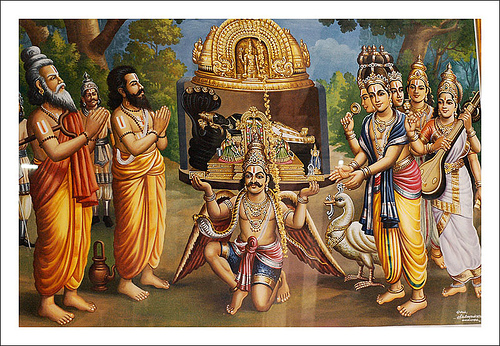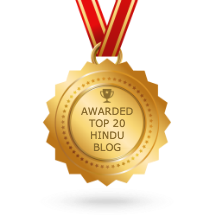Garuda, the vehicle of Lord Vishnu, carries the deity of Ranganatha while Lord Brahma looks on. I spent a rewarding day in the town of Ranganatha recently, and what follows is an extract from my ‘India Diary’ written earlier this year:
January 14th – A Full day in Sri Rangam
Yes, this was a very full day – from before dawn until after dusk. The town of Sri Rangam, which lies just over the Kaveri river from Tiruchirapalli, is very significant in the history of Vaishnavism. Of all the 4000 hymns of the Divyaprabandha, the ‘Tamil Veda,’ the Lord of Sri Rangam has the most hymns dedicated to Him.
It is considered the most sacred place of all the 108 temples sung about by the Alwars. The Alwars, or ‘those who were immersed,’ lived from thousands of years ago up to 900 AD. They are the first section of the disciplic succession of Lakshmi Devi, known as the Sri Sampradaya. Although most of them, due to the dates they appeared in the world, did not know each other, their teachings and hymns were consistently in praise of the power, grace, wisdom, beauty and compassion of Lord Vishnu and His consort Lakshmi.
They would also sing of the Lord as being the presiding deity of one particular place rather than being far away in the spiritual realm of Vaikuntha. Thus He is addressed as ‘The Lord of the Seven Hills,’ for instance, after appearing in that place. Srila Prabhupada also did this when he named the deity of Lord Krishna as ‘The Lord of London’ or Londonishvara.
After the Alwars came an acarya named Sri Nathamuni who collected all the Alwars’ songs and disseminated them widely. Although Sanskrit was the language for scripture and philosophical discussion, this was an additional tradition being created; one which the local non-Sanskrit speakers could access. The Divyaprabandha became popular and is the basis of dance, drama, and poetics in the souther part of India.
Sri Ramanujacarya
And then came Sri Ramanujacarya (1017-1137) who lived in Sri Rangam from around 1070 until he died. He travelled extensively, revitalised the tradition even further; restored and systematised the ceremonial worship in the temples sung about by the Alwars, and wrote nine philosophical works giving an enhanced theological foundation for this devotional tradition.
The temple of Sri Rangam is a magnificent creation with the tallest gate towers in Asia (257 feet) and seven concentric walls enclosing 155 acres of sacred space. It was attacked by Moguls in 1310 and 1323 and many brahmans were killed. Although the soldiers tried to smash the altar they were fooled by Vedanta Deshika who created a false one, walling in the actual deities.
Lord Ranganatha is Vishnu, who is also known as Narayana. He is depicted reclining on the serpent bed of Ananta Shesha, who is none other than Sankarshan or Balarama (whose full-moon appearance day it is today). The black deity was given as a gift to Vibhisana, the brother of Ravana, by Lord Rama. Ever since those days He has been worshipped here. Gradually the temple was built by successive kings and grew to have seven walls as each king made an architectural contribution.
There was a time, many hundreds of years ago, when the daily worship diminished and the jungle grew in towards the small existing temple, causing the pujaris to fear for tigers. Then the spirit of bhakti was rekindled and the wealth and support was found to develop the temple once again.
Lord Shri Chaitanya Mahaprabhu stayed here in 1510 for the four months of the rainy season. He stayed with one brahmana known as Vyenkatta Bhatta who had a son named Gopala. This young boy went on to become one of the famous Six Goswamis of Vrindavan: Gopala Bhatta Goswami. Lord Chaitanya felt such separation from Jagannatha that he carved his own set of Jagannatha deities and they are still there today, not far from the original home of the Bhatta family.
The tomb, or samadhi, of Ramanujacarya is also in a good sized shrine within the Sri Rangam temple compound, except that Ramanuja is not actually buried. He went into a trance in 1137 while sitting in the lotus position, and his preserved body is still sitting upright within a covering. It is still visible to all the pilgrims.
Ramanuja’s disciple and secretary, Koorathalwar, was always found at his master’s side. His samadhi is just outside the temple. I entered this temple and paid my respects. There are two black granite Narasimhas and a magnificent utsava-murti (festival deity) in bronze. The day I visited just happened to be a monthly time for abhisheka, the ritual bathing of the deity, so I sponsored it and watched as juices and milk were poured over the half-man, half-lion form. Afterwards I was given curd rice by the pujari who took me to his simple house nearby – built in the 1100s – and explained the difficulties he was having with the state of repair of the mediaeval temple. (Anyone who would like to help repair this temple please drop me a line)
Visiting Sri Rangam gave me some insight into the essential factors for developing and sustaining Vaishnava culture in any part of the world: Spiritual purity, knowledge from and devotion to the predecessor acaryas; determination; scholarship and intellectual strength; production of literature; dissemination and popularisation of the tradition; systematising and sustaining of temple worship and religious culture; support from leaders and thinkers; and protection from enemies.





Hare Krishna Prabhu,
A concisely written article on Lord Ranganatha and Sripad Ramanujacarya. Really well done.
Your servant,
Sathiya Ramakrishnan.
The best site with outstanding picture gallery, hats off to the one who made it..
congratulations.
Good,
A very good article on Lord Ranganatha, Srirangam and Srimath Ramanujaa,
Hats off for your nice work,
May Ramanujaa bless you,
Magesh G
Hello,
A well written article and the photo of Sri Ramanujacharya is astonishing. I have lived in Srirangam for 6 years and I miss the holy town very much. This article brings me those old memories.
Many Thanks,
Adyen Ramanujadasan
You have done a lot to develop the Indians
very very good article &it is good
I’m exciting to read this article, where is the same excitement when I feel my ‘Thiruthangalappan’.
Nice and good article.
Well written article Prabhu. Looking forward to more such articles from you.
Adiyean.
…and you have a nice Sri Vaishnava site Ramanuja dasan. I hope some of my readers will go there and read the interesting articles you have written there. For those who search for Vaishnavam but are from the Western countries, you might like to include the more common expression “Vaishnavism” in your text. Then the search engines will pick it up. Devotees of Krishna also spell it “Vaisnavism” as in their transliterated Sanskrit according to the ITRANS format.
Thats an nice suggestion Prabhuji. Will try to incorporate your idea.
Meanwhile please have a look at a post on Rameswaram in my blog – http://ramanujadasan.wordpress.com/2008/12/25/following-sri-rama/
[I hope I am not unethically promoting my blog]
Adiyean.
Hello Sir,
I am very thankful to you for the information you have gathered and mentioned here.
Same time felt sad to hear such a temple is neglected .
I am a very common man..but still having the have to show my gratitude to SriRanganatha…
Please tell me how can I uselful for the repairs…..
Regards,
Ravi
Ravi, this little temple is in the first courtyard outside the Ranganatha temple. You can ask for the Kuratalwar Sannidhi and most people will know it.
Really beautiful article.
Thank you
Thank you Srinivasaraghavan, it is a beautiful town. Where are you residing? Do you also go to Sri Rangam?
i am 75 yrs old but i am a great devotee of sree ranga swami i like this one as there are my favorite gods including Ramanujan swami i was very much thank ful to u sir
Hai , I visited Sri Rangam this year on Jan 25th . Its really an awesome place. My trip was full of Lord’s Grace.
an excellant attempt. this is possible only with the grace of Lord Ranganathar. I have visitedthe temple many times and had dharshan of perumal and thaayar and other sannathees.
It is extreamly sad to say that infront of garuda aalwar sannidhi people take their break fast and lunch by liking and touch the sculpitres. Though private
worik force cleanthe area time to time it is only dry clean and not wet clean. We must follow the cleaniness and systems from the Malayalam devotees who keep their temples very clean and follow the stict proceedures.
Otherwise every thing is fine.
S.Radhakrishnan Navi mumbai